Research and understanding of COVID-19 and infectious diseases in general continues to be a moving target. Many experts believe that HVAC systems, particularly those in most non-medical buildings, are typically a small factor when it comes to transmission of infectious diseases. However, this hypothesis is simply based on what appears to be reasonable assumptions based on available data, which has not yet been validated. Just like we wouldn’t (or shouldn’t) take medication without fully understanding its side effects, one should not simply take generally made recommendations as a solution for all situations.
Particularly when it involves modifying a building’s HVAC system, making the wrong decisions could have adverse effects not only to the building itself but also to public health. Many of these adverse effects — which could include higher moisture/humidity levels, continuous temperature fluctuations, condensation and/or microbial/mold growth build-up on surfaces — may not immediately come to light because everyone’s focus is on the current COVID-19 crisis.
The Current CDC/ASHRAE Guidelines
Current guidelines from the Centers for Disease Control (CDC) and American Society of Heating, Refrigeration, and Air-conditioning Engineers (ASHRAE) have some general recommendations in place. Their main intent appears to be to reduce disease transmission from airborne particles by increasing outdoor air ventilation and filtration efficiency. However, these recommendations are vague and appear to take a “one approach for all” method without considering the location and climate where the facilities are located. A facility located in Boston, for example, should not be designed the same if it were located in Miami. Weather — and, more importantly, moisture — in outdoor airflow is drastically different, particularly in warmer southern climates. Therefore, what may work for one location will not work the same for another.
CDC guidelines, as they relate to modifying HVAC systems to handle the COVID-19 pandemic, state the following:
Consider improving the engineering controls using the building ventilation system. This may include some or all of the following activities:
- Increase ventilation rates.
- Increase the percentage of outdoor air that circulates into the system.
According to a March 31, 2020 news article, ASHRAE has established an epidemic task force to respond to the global COVID-19 pandemic. As of April 15, 2020, the following statement from the ASHRAE Epidemic Task Force was posted on their website:
- On the recommendation of the ASHRAE Epidemic Task Force, ASHRAE leadership has approved the following two statements regarding transmission of SARS-CoV-2 and the operation of HVAC systems during the COVID-19 pandemic:
- Transmission of SARS-CoV-2 through the air is sufficiently likely that airborne exposure to the virus should be controlled. Changes to building operations, including the operation of heating, ventilating, and air-conditioning systems, can reduce airborne exposures.
- Ventilation and filtration provided by heating, ventilating, and air-conditioning systems can reduce the airborne concentration of SARS-CoV-2 and thus the risk of transmission through the air. Unconditioned spaces can cause thermal stress to people that may be directly life threatening and that may also lower resistance to infection. In general, disabling of heating, ventilating, and air-conditioning systems is not a recommended measure to reduce the transmission of the virus.
The general consensus from both CDC and ASHRAE appears to be that increasing both ventilation and filtration can reduce the risk of COVID-19 airborne transmission. While some of these recommendations may be able to be implemented with little to no effect on the current HVAC systems, it is important for a facility owner or manager to fully understand the effects these recommendations may have on their specific systems before implementing them, potentially wasting time and resources only to make their building’s interior conditions worse. Therefore, let’s discuss each of the general recommendations noted above and how they affect a particular building or facility.
Increasing Outdoor Air Ventilation
While studies have shown that increasing ventilation within a building can be an effective way of reducing the potential for airborne transmission, simply doing so may have some unintended consequences. Depending on the climate, increasing ventilation into a building — either through mechanical means or simply opening a window — increases moisture infiltration into the building as well. The effects of moisture within a building depends on a variety of factors, which include but not limited to, current HVAC design and operation, exterior climate conditions, construction type, and the types of building materials used. Before one can fully understand the effects of moisture, one needs to understand that moisture will still infiltrate into a building, even if an HVAC system is off.
Vapor Pressure and Relative Humidity
Vapor pressure is essentially the portion of atmospheric air pressure attributable to water vapor. In short, air is primarily made up of nitrogen and oxygen; however, several other small amounts of gases (usually less than 1 percent) also exist. In addition, the air molecules also include a portion of water vapor, the amount of which depends on the atmospheric conditions (i.e. temperature) in which it resides.
As air temperature increases, so does its ability to hold more moisture. The specific amount of moisture that air can hold at a particular environmental condition is typically referred to as specific humidity. However, most people usually refer to humidity levels in a term called “relative humidity” or percent RH. Relative humidity is the amount of moisture air can hold compared to the maximum amount of moisture the air can hold at a specific temperature. For example, air at 75°F and 50 percent RH means the air is holding 50 percent of the total capacity of moisture it has the ability to hold while at 75 percent.
Just as the ability to hold more moisture when air temperature is increased, if you decrease air temperature, the ability of the air at the cooler temperatures to hold moisture decreases also; however, the relative humidity actually goes up, while the specific humidity remains the same. When relative humidity reaches 100 percent, the air is considered saturated and condensation will form. The air temperature at this point is typically referred to as the “dew point” temperature. Dew point temperature is the temperature at which water vapor condenses in the air.
In addition, warmer air also has a higher vapor pressure than cooler air. The higher pressure of warmer air tends to move toward areas that have lower vapor pressures. This process is called “diffusion.” This is essentially the natural tendency of air to want to move from warm to cold. This is why one typically insulates buildings in south Florida — to keep out the heat and moisture from the exterior and the indoor conditioned air within the interior spaces. Insulation and air conditioning will never stop the occurrence of vapor pressure and its tendency to want to infiltrate from the exterior, as this occurs naturally in nature. However, the intent of proper HVAC design depends on the understanding of both the HVAC system and the building envelope in which it resides.
The diffusion process depends on many factors. Some of these include the construction of the building envelope, insulation properties, and quality of the construction itself. In addition, the exterior environmental conditions and interior space conditions play an important role as well. As previously indicated, the higher the temperature and humidity, the higher the vapor pressure is at those conditions. The vapor pressure differential between the exterior and interior environments affects the rate and ability for warmer air to infiltrate into cooler spaces. The higher the pressure differential, the easier it is for warmer air — and subsequent higher moisture quantities — to infiltrate a space.
It is possible to elevate the vapor pressure differential by increasing the outdoor environmental conditions and maintaining a stable indoor environment. However, the opposite is also true. The vapor pressure differential may also be increased by decreasing the interior space temperature conditions while maintaining a stable exterior environment. Many people do not typically think about the latter; however, many indoor environmental problems occur for spaces that are potentially too cool, just as they do when they are too warm.
An example of this is having a space located in an area where the exterior conditions are typical of south Florida — approximately 91°F dry bulb (DB) and 78°F wet bulb (WB). Per air psychrometric charts from ASHRAE, the vapor pressure at these conditions is approximately 0.83 inches of mercury. Typical indoor space conditions of 75°F and 50 percent RH translate to a vapor pressure of approximately 0.45 inches of mercury. This correlates to a vapor pressure differential of approximately 0.38 inches of mercury. If one were to decrease the indoor space conditions to 70°F and 50 percent RH (vapor pressure – 0.34 inches of mercury), the vapor pressure differential would increase to 0.49 inches of mercury (0.83-0.34). See Figures 1 and 2 below.
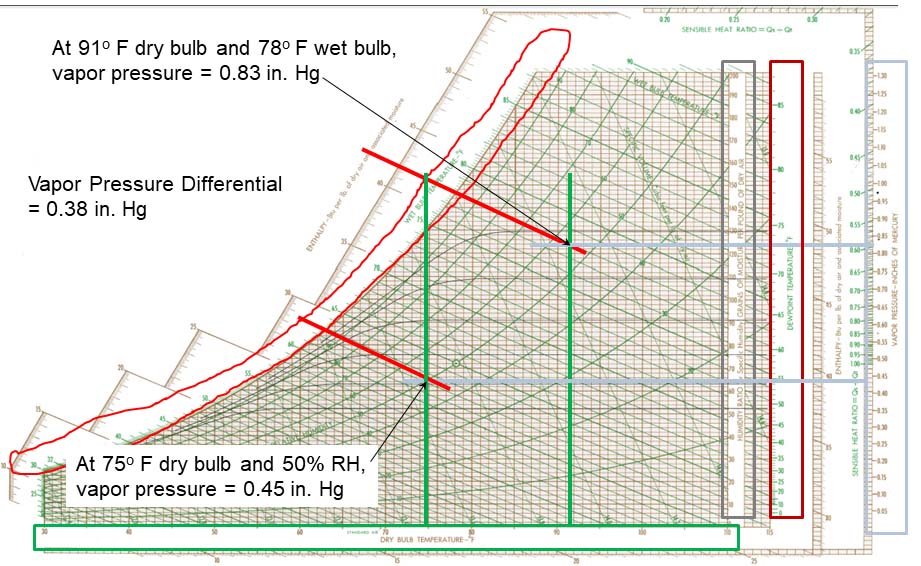
Click chart to enlarge
Figure 1: Vapor Pressure between 91°F DB/78°F WB and 75°F DB/50 percent RH = 0.38 inches Hg
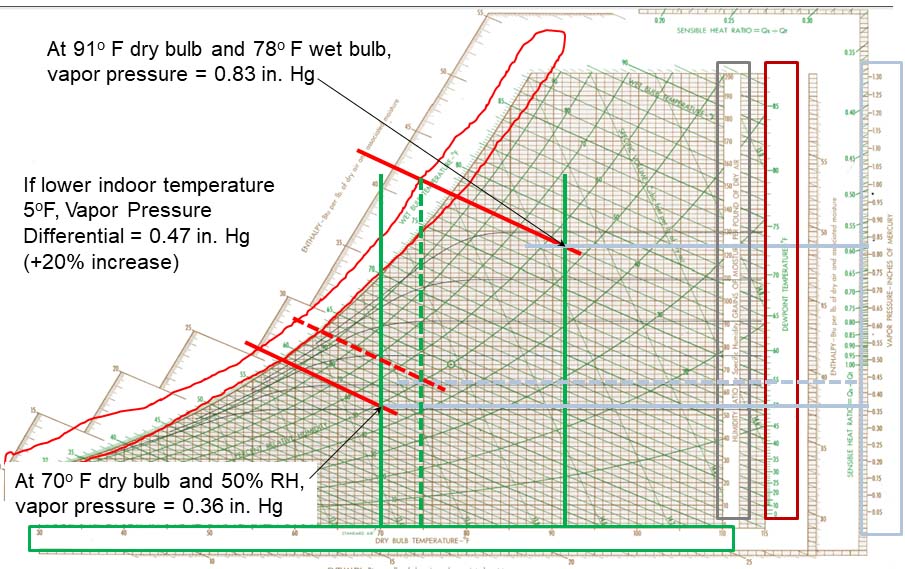
Click chart to enlarge
Figure 2: Vapor Pressure between 91°F DB/78°F WB and 70°F DB/50 percent RH = 0.47 inches Hg
The proper balancing of outdoor and exhaust airflows within a space is essential in maintaining a proper indoor environmental condition for both comfort and health/safety of indoor occupants. It is important to realize that if one were to increase ventilation within a space, it creates the potential for increasing relative humidity. According to ASHRAE Standard 8, occupied spaces should be controlled to limit the indoor humidity to a maximum dew point temperature of 60°F, which — assuming an ASHRAE-recommended comfort level dry-bulb temperature between 72°F and 78°F9 — corresponds to a maximum relative humidity level of between 55-65 percent RH. Therefore, the operation of HVAC systems should be controlled to achieve levels below the recommended dew point temperature at all times, regardless of COVID-19 or other potential similar threats, to prevent the potential for other adverse effects relating to moisture and condensation to occur.
Spaces considered to be under “negative” pressure may introduce excess unconditioned outdoor air and associated moisture into the interior spaces, thus increasing humidity levels and causing discomfort to occupants. Most occupants unfamiliar with air properties would tend to lower the space temperatures via a thermostat or have their air conditioning systems run longer to remove the excess moisture. However, this sometimes can create an adverse effect, as it may end up pulling more moisture into an interior space due to diffusion. This may lead to the same or additional problems with regard to maintaining proper interior temperature and humidity levels and controlling interior moisture levels.
Consider Your Environment and Building Systems
In summary, moisture will get into buildings at some point, whether you want it to or not. Therefore, the key is to control the quantity so it doesn’t have an adverse effect on the building materials and personnel within your building. Before running around the building and opening every outdoor damper 100 percent, consider the location of your building. Buildings located in warmer climates will typically have greater quantities of moisture in the outdoor air and, therefore, will have more moisture to control once it’s inside the respective building. That’s not to say that buildings in cooler climates will not have similar issues, as they will need to deal with moisture in warmer months and heating the extra outdoor ventilation in cooler months.
Some HVAC systems are better than others with regards to controlling moisture. However, each system within a building was likely designed to handle a specific quantity of outdoor air ventilation per ASHRAE guidelines. Increasing the outdoor air ventilation for a specific air handling unit (AHU) system increases the mixed air temperature being delivered to the cooling coil, which in turn increases the supply air temperature leaving the AHU that is delivered into the space — along with any excess moisture the AHU system was not able to remove. This excess moisture not only makes occupants feel uncomfortable but can also lead to condensation/moisture, which can settle on various building materials and lead to microbial growth if not corrected. Specific AHU systems may have some ability to be adjusted in order to handle some excess outdoor air, but this should be evaluated by a licensed mechanical engineer or vendor familiar with such systems before any changes to the systems are made. In addition, should additional outdoor air ventilation be introduced into a building and controlled properly by the existing HVAC system, this excess outdoor air ventilation will need to go someplace. Therefore, the capacity of the exhaust system to handle this additional ventilation should be evaluated as well.
It is important to remember that excess moisture from a warm environment into a cooler environment also brings the added potential for condensation to form. This is particularly apparent around areas where, for example, duct leakage may be occurring. Therefore, it is imperative to verify that insulation around ductwork, air devices, piping, and air handling equipment is properly installed. In addition, insulation surrounding building envelope areas including attic spaces should be checked for proper consistent installation throughout and repaired/reinstalled as necessary to assure that condensation will not be able to form on or around the surfaces of these and surrounding components. Any added moisture from additional outdoor air that is not properly controlled can potentially make these conditions worse.
If a building utilizes a plenum system, consideration should be given to providing a fully ducted system, even temporarily, to avoid the potential for the spread of airborne particles due to the difficulty to fully control the air movement within a plenum-based system. However, it is understood that existing building configurations may not allow for such a system to be constructed cost-effectively. Outdoor air ventilation directly into a plenum space — above a ceiling, for example — should be avoided for many of the reasons noted above. If at all possible, outdoor air should be ducted directly to the return side of its respective AHU system, allowing return/outdoor air mixture to occur directly at the AHU and not in the plenum space. This way, the outdoor air ventilation and its associated moisture will have a better chance to be conditioned before it enters the occupied spaces.
Increasing Filtration
Most would agree that upgrades to filter efficiency, whether it’s a mask or an AHU system, would be an effective way to assist in filtering out unwanted airborne particles. However, careful consideration needs to be made when selecting the types of filters used for existing AHU systems.
A plenum system is a space within a building utilized for air circulation for HVAC systems. Typically plenum spaces are located above ceiling spaces, below floors or within mechanical rooms and are used as mixing chambers typically for return, outdoor air, or both.
In general, filters with higher MERV ratings have smaller openings in them, which allow the higher MERV filters to capture more and smaller airborne particles. However, this can restrict the airflow passing through them. Increasing filter efficiency means increased resistance or static pressure within a system, which relates to a drop in airflow velocity across the filter itself. This can lead to an overall drop in total airflow being delivered to a space. In addition, if the velocity — particularly across a cooling coil — is too low, this can lead to coils freezing up.
However, how the airflow behaves depends upon the type of HVAC system and — specifically — the fan serving it. In order to counteract this effect, the system must have a way to make up the difference of the greater pressure drop caused by the increased filter efficiency. In some larger AHU systems, simply increasing the speed of the fan or the even the horsepower (hp) of the fan motor may make up for the added pressure drop within the system. However, for smaller AHU systems, such as those found in most residential, multi-family, and light commercial buildings, the installed AHU systems likely do not have these capabilities due to the size and hp limitations of the supply fans themselves.
All filters have specific pressure drops associated with them, which varies depending upon the type of the filter itself as well as the quantity of airflow across it. Pressure drops also increase as the filters become dirty. Installing a higher efficiency filter may work fine initially while the filter is clean but may not when the filter gets dirty, as the AHU fan may then be outside its performance range, resulting in a decrease in total airflow. Therefore, one needs to analyze the AHU system to determine if the system can accommodate a higher efficiency filter as recommended by ASHRAE.
Typical residential type AHUs may not be suitable for high efficiency MERV-13 or above filters. Verify the AHU performance including ductwork layout to determine if such filters are suitable for its intended application.
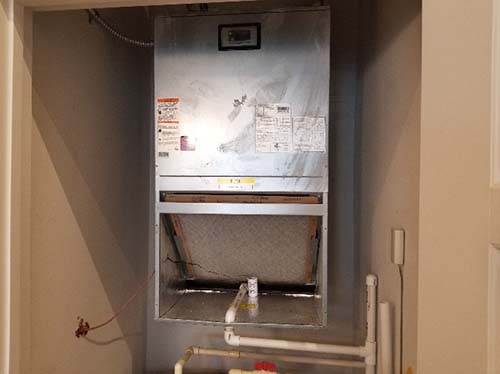
Typical residential type AHUs may not be suitable for high efficiency MERV-13 or above filters. Verify the AHU performance including ductwork layout to determine if such filters are suitable for its intended application.
Therefore, as noted above, it is important to have each system evaluated by a licensed mechanical engineer or vendor familiar with such systems before any changes to the systems are made. This may include verifying the AHU system performance by a licensed test and balance or mechanical contractor to assure the system is performing in accordance with its intended design standards — and also to verify what, if any, excess capacity the respective systems have before making temporary or permanent changes to their current operation.
In addition to selecting the proper filter and respective filter efficiency, careful consideration and protocols should be employed to removing and disposing of used filters. This includes wearing the proper personal protective equipment (PPE) in accordance with CDC recommendations; protecting the surrounding work environment with proper drop cloths or similar enclosures to collect any particles which fall during filter extraction; cleaning and/or disinfecting/sanitizing the surrounding surfaces before new filters are installed; and properly bagging/disposing of all used filter media per CDC and related guidelines. Consulting with a licensed engineering firm for the development of such protocols and standards can be an option for those facility managers wishing to improve their standard operating procedures.
Other Considerations
ASHRAE’s recommendation to “Keep systems running longer hours, if possible 24/7, to enhance the two actions above” may be warranted, but it is not without its own concerns — namely, the increased usage of energy and the potential for overcooling the space. Overcooling the space can bring detrimental effects to a building for many of the reasons noted above. Therefore, controlling the space temperatures by adjusting control settings — namely, night setback settings — may assist with maintaining a proper indoor environment.
Controlling energy usage, and the costs associated with it, has always been of importance to any building owner or facility manager. Many, if not all, would agree that the safety of the public is on everyone’s mind these days much more than energy savings. Nevertheless, if additional measures are implemented, it would be in the facility manager’s and ownership’s best interest to provide the additional measures in the most cost effective way possible without jeopardizing the health and safety of the building’s occupants. This may include evaluating whether the additional costs to implement such practices in the short term make economical sense versus shutting down the respective building(s) altogether, assuming that is an option. Unfortunately, many essential businesses do not have the luxury of the latter and need cost-effective ways to implement these additional safety measures without being detrimental to both their occupants and their business continuity plan.
Portable room air cleaners with HEPA filters as well as UVGI systems may provide added protection for indoor occupants. However, like any new system, the incorporation of these type of systems should be evaluated prior to installation to determine how and if operating these new systems will negatively affect the performance of the existing HVAC systems currently serving the respective buildings.
Conclusions
The reality is that there is always a way to do something better. This article is not in any way recommending that additional measures, like those proposed by ASHRAE and the CDC, be overlooked. There are simply many factors related to HVAC performance that are not commonly thought of when trying to implement general recommendations, including building location, construction type, building envelope, and how well the building was constructed in the first place. Therefore, it is always in the best interest of any facility/building owner, manager, and building occupants to determine the pros and cons of any recommendation and how they will work specifically for their building and respective HVAC systems. It is much more valuable to spend some time analyzing the proposed changes before spending the extra time and money to implement them and finding that the work performed to initially achieve a betterment in the short term may be detrimental in the long term to the facility.
1 MERV-13 Is approximately equivalent to F7, a rating used in the EU. More effective filters with reasonable pressure drop are available, and some increased pressure drop often results in an acceptably small effect on system performance.
2 Consider the filters contaminated, protect personnel changing them, and seal them in plastic bags for disposal.
3 This applies to systems that deliver air to the occupied space and, to a lesser extent, room air returned to rotary heat exchangers, in order to reduce cross contamination.
4 There is research that shows UVGI in both the upper-room and in-duct configurations can inactivate some disease-transmitting organisms. Either of these takes time to plan and install. For more information, see the ASHRAE PD previously cited and Chapter 62 Ultraviolet Air and Surface Treatment of 2019 ASHRAE Handbook—HVAC Applications.

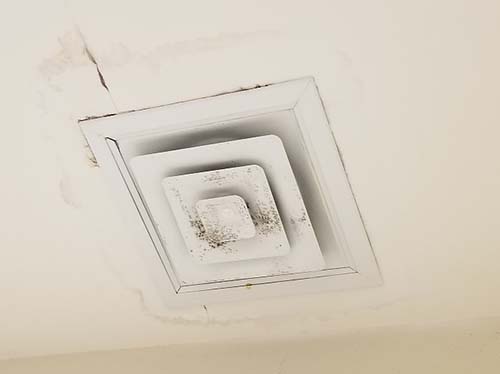
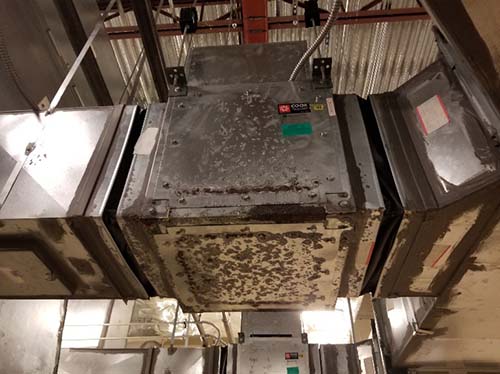
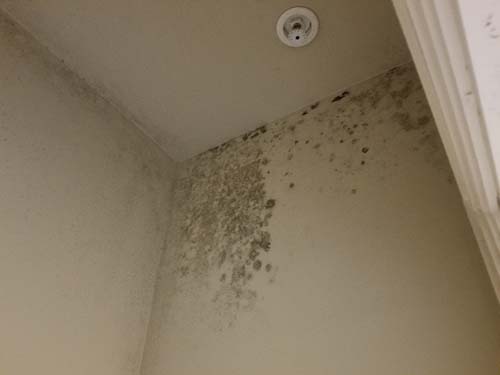
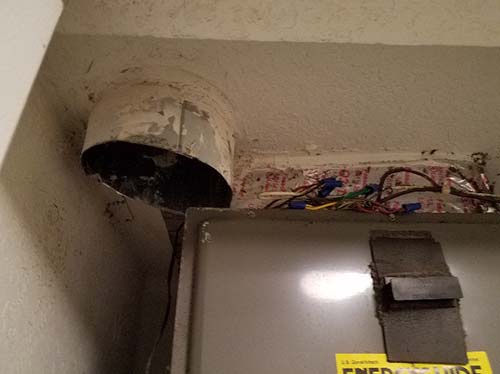

Report Abusive Comment